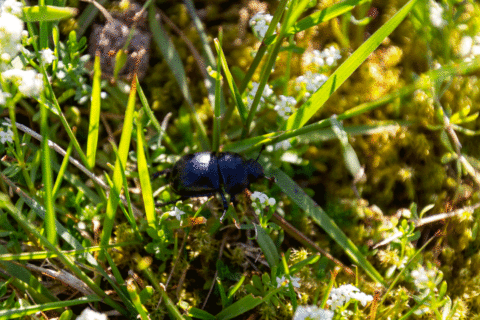Clemencia in Potomac, Maryland, writes: “Could you look at the attached picture and tell me if the bug is a squash vine borer?
“If so, is there anything I can do at this juncture in the growing season to protect my squash plants from borers? I love zucchini, but every single year I am crushed to see my beautiful plants die off before producing any fruit.”
The adult vine borer is a very colorful moth that is often mistaken for a bee or a wasp. Females lay their eggs at the base of squash plants, and the little caterpillars that hatch out of those eggs tunnel into the stems, killing the plant. Unfortunately — or maybe fortunately — the insect that Clemencia sent pictures of is the beloved lightning bug (or firefly).
By either name, they are the luminescent wonders of summer and don’t harm plants.
Beat the borer
The best defense against the squash vine borer is to wrap the stems with medical gauze or tinfoil at planting time to deny the little buggers their meal.
At this time in the growing season, your best bet is to wipe the lower portion of the vines down weekly with a damp cloth or use sharp sprays of water to dislodge any freshly laid eggs. It may sound too easy to be true, but it was found by researchers to be highly effective.
That’s no way to treat a violet
Sandra in Germantown writes: “Our lawn is covered by violets every spring; they don’t have flowers anymore, but the plants remain. How do we get rid of them? When is the best time to treat them?”
“Treating” wild violets with chemicals is useless, Sandra. Those pretty little flowers, and their big clumping plants are incredibly herbicide-resistant. Your best bet is to make peace with the plants. The flowers are beautiful and edible and serve as a host plant for a fabulous butterfly.
If violet free you must still try to be, you’ll have to dig up every clump — or have the area cleared with a backhoe — over the next month and be prepared to sow fresh grass seed in late summer, between Aug. 15 and the middle of September.
The good news: A lawn that is sown at the correct time of year — that’s late summer/early fall for cool-season grasses like bluegrass and fescues — and then cared for correctly is highly resistant to unwanted plant invasion.
Shredded paper: To compost? Or not compost?
Paula, who listens to WTOP in Shepherdstown, West Virginia, writes: “I’ve read conflicting information about the use of shredded paper (of which I have lots!!!) in compost piles — some sources say to use them, others say not to because of chemicals in the paper … what do you recommend?”
I recommend recycling paper the same way we do cans and bottles: either at curbside (in areas with good recycling pickups) or at the closest recycling center. Or toss it into one of those big “we want your paper” dumpsters that are abundant in our region. (It sometimes seems that most schools have one in the parking lot.)
Shredded paper is a valuable commodity that gets repurposed and reused, and it makes sense to use the existing waste streams to move it along. (You may well wind up using your paper again in the form of tissues or paper towels!)
I don’t advocate its use in composting, but more because there is no nutrition in paper than because of any fear of toxins. Shredded paper will become compost eventually, but that compost will be the equivalent of really weak tea. Shredded leaves are the dry brown carbon-rich material you want to use to build a proper pile.
Deer ate my day lilies
Paula has another question. She writes: “I have orange flowered lilies that are — or were — beautiful this year … until the deer took a liking to them! I have two flowers left from all the plants. Any ideas to keep them away? Human hair and urine didn’t work.”
People love to try home remedies and recipes like human hair and Irish Spring soap, but there is no evidence that these things work. The most effective way to prevent deer browsing is to aim a motion-activated sprinkler at the area; the sudden spray of cold water doesn’t harm the deer but sends them running. And you only need to buy it once.
Otherwise, begin spraying the flowers with a strong commercial deer repellent as soon as the buds appear; products with “putrescent egg solids” as the active ingredient have been shown to be the most effective.
Mike McGrath was Editor-in-Chief of ORGANIC GARDENING magazine from 1990 through 1997. He has been the host of the nationally syndicated Public Radio show “You Bet Your Garden” since 1998 and Garden Editor for WTOP since 1999. Send him your garden or pest control questions at MikeMcG@PTD.net.







